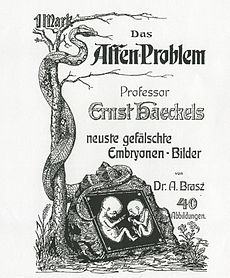Arnold Braß
Arnold Braß (also Brasz or Brass ; born May 22, 1854 in Arolsen ; † November 7, 1915 in Godesberg ) was a German scientist, text and textbook author and, as a member of the Keplerbund, a sharp critic of Ernst Haeckel in the embryo controversy .
Life path
After studying engineering, chemistry and physics at the predecessor institution of the Technical University in Hanover from 1874 to 1876 and mathematics and natural sciences at the University of Leipzig from 1876 to 1879, he was there with a thesis on the knowledge of the female urogenital system of the Marsupials to the Dr . phil. PhD. From 1879 to 1885 he was then an assistant at the University of Halle , then in the same function at the University of Marburg .
After unsuccessful attempts at habilitation , he settled as a private scholar in Göttingen in 1889, then in Wernigerode, and later in Weimar, Siegburg and Godesberg. As the author of numerous richly illustrated textbooks and specialist books, magazine articles and teaching blackboards for school and university lessons with large editions, he found his economic livelihood and recognition. His actual scientific work - for example on the theory of light and color - found little echo.
Confrontation with Haeckel
Arnold Braß attracted a great deal of attention in the scientific world at the beginning of the 20th century when he published the brochure Das Affen-Problem: Professor E. Haeckel's manner of representation and fighting in a matter-of-fact manner along with remarks on the respiratory organs and body shape of vertebrate embryos with the sensational cover title Professor Ernst Haeckel's latest fake embryo pictures went public; two years earlier he had already attacked Haeckel in a letter without any noticeable reaction. Braß succeeded in proving that Haeckel had not proceeded scientifically flawlessly with the illustrations of his evolution theory through pictorial representations of the embryonic development and had changed individual images in the drawing in accordance with his theory. Braß saw his discovery in the lively discussion between Darwinian and Haeckelian “ evolutionists ” on the one hand and the representatives of creationism and an integration of scientific knowledge into the concept of Christian religious doctrine, which emphasized the God-given special position of man in creation, on the other striking evidence against a leading evolutionist and thus against evolutionism itself. He received strong support in his arguments from the Keplerbund , to which he belonged until 1912.
Although Haeckel had to admit the "embellished" representations - he justified them with didactic necessities - a number of well-known natural scientists took his side; Braß 'following, especially from the natural sciences, remained modest. The dispute, in part polemical in numerous publications, was ultimately decided in favor of Ernst Haeckel.
Others
Braß is on February 3, 1887 Marburg in the Masonic Lodge Marcus Aurelius for Flaming Star that the Grand National Mother Lodge "The Three Globes" has taken part; he remained its member until his death.
Fonts (in selection)
- Contributions to the knowledge of the female urogenital system of the marsupials , Leipzig 1880 (dissertation)
- Outline of zoology for students, doctors and teachers , Wilhelm Engelmann, Leipzig 1882
- The organization of the animal cell. Hall 1883.
- The thieric parasites of man [sic!], Theodor Fischer, Cassel 1884
- Outline of the anatomy, physiology and history of human development. Leipzig 1884.
- Chromatin, cell substance and nucleus. Marburg 1885.
- Short textbook on normal human histology and typical animal forms , Theodor Fischer, Cassel and Berlin 1885
- The cell, the element of the organic world. Leipzig 1889.
- Boards on the development history and topographical anatomy of humans. Leipzig 1890.
- Atlas of general zoology and comparative anatomy. Leipzig 1893.
- Atlas of human tissue theory for students and doctors. Leipzig 1897.
- The child healthy and sick. Osterwieck 1900.
- Investigations into light and colors. Osterwieck 1906.
- At the limit of life. Leipzig 1908.
- Prehistory of man. Leipzig 1914.
- To the descent of man. Leipzig 1914.
On the controversy with Haeckel:
- Ernst Haeckel as a biologist and the truth. Stuttgart 1906.
- The monkey problem: Professor E. Haeckel's way of representing and fighting objectively explained, along with remarks on the respiratory organs and body shape of vertebrate embryos , Leipzig 1908.
swell
- Andreas W. Daum: Science popularization in the 19th century. Bourgeois culture, scientific education and the German public 1848–1914. Munich 2002.
- Heinrich Zankl : forgers, swindlers, charlatans. Research and Science Fraud. Weinheim 2003.
- Ders .: fighting cocks of science. Controversy and enmity. Weinheim 2010.
- Marburg Freemason Documentation. Edit v. Helmut Keiler. Giessen 1980 [University Library Marburg].
Individual evidence
- ^ Andreas W. Daum: Science popularization in the 19th century. Civil culture, scientific education and the German public, 1848–1914 . Oldenbourg, Munich 2002, p. 233-235, 477 .
| personal data | |
|---|---|
| SURNAME | Braß, Arnold |
| ALTERNATIVE NAMES | Brasz, Arnold; Brass, Arnold |
| BRIEF DESCRIPTION | German scientist, textbook and textbook author and, as a member of the Keplerbund, a sharp critic of Ernst Haeckel |
| DATE OF BIRTH | May 22, 1854 |
| PLACE OF BIRTH | Arolsen |
| DATE OF DEATH | November 7, 1915 |
| Place of death | Godesberg |
